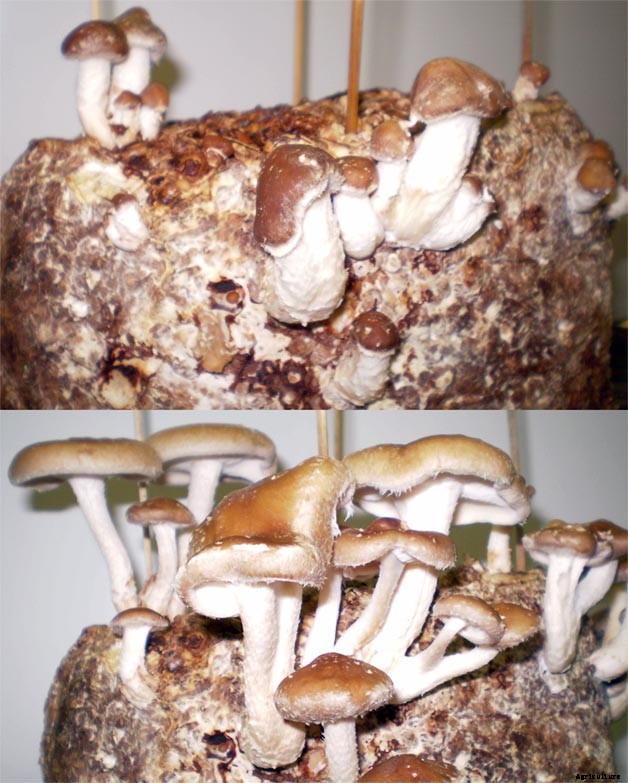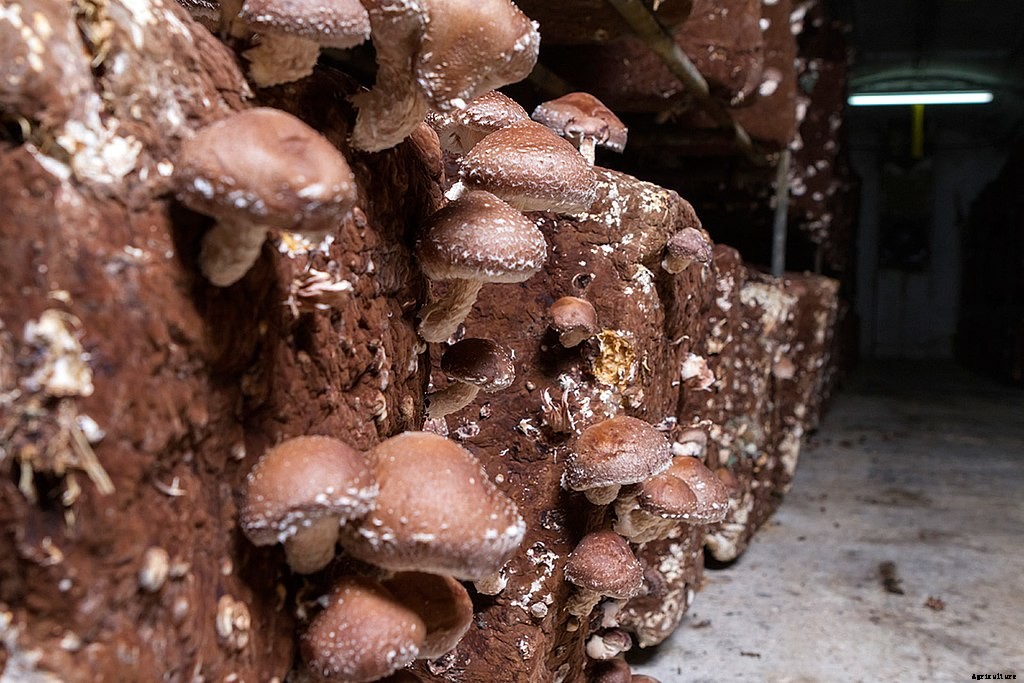20 のこぎりの頭、 タングステンチップブレード、 最大8フィートの成長をカット、 2.5トンから5トンのトラックマシンに適合小型のヘッジカッターに適合、 トラックソーは、3ウェイヒッチと取り付けブラケットを備えています。ヘッジカッターは、標準のヘッジカッター取り付けブラケットを備えています。 360度ローテーター付き3トングラブ 360度ローテーター付き3トングラブ 理想的な材木グラブスーツ2〜5トン360度掘削機
インドでのきのこ栽培は、多くの人々の利益の代替供給として段階的に成長しています。www.modernagriculturefarm.com世界的に、 アメリカ、 中国、 イタリアとオランダはきのこのトップ生産国です。インドで、 ウッタルプラデーシュ州はキノコの主要な生産者であり、トリプラ州とケララ州がそれに続きます。
きのこ栽培とは?
きのこは菌類の実を結ぶフレームです、 リンゴがリンゴの木の実体であるように。きのこは、ラテン語でAgaricusbisporusという名前の真菌の一種です。菌類に属するきのこは、栄養価の高い菜食主義の珍味であり、高品質のタンパク質(乾燥重量の20〜35パーセント)の優れた供給源です。現在、3種類のきのこが栽培されています。 白いキノコ(Agaricus bisporus)、 水田フクロタケ(Volvariella volvacea)とカキキノコ(Pleurotus Sajor-Caju)。
野菜王国では、 きのこは従属栄養生物(下等植物)にランク付けされています。高とは異なり、 緑の植物、 これらの従属栄養生物は光合成することができません。菌類は自然のスカベンジャーです。きのこ栽培では、 鶏糞からなる廃棄物、 馬の糞尿、 ストロー、 石膏と廃水(独自の堆肥から)は、キノコが成長する高満足度の基質を提供するために使用されます。アンモニアは、自然に戻る前に、アンモニア洗浄機を介してプロセス空気から除去されます。空気中のアンモニアでさえ、堆肥化の窒素源として使用されます。
真菌、 菌糸体とも呼ばれ、 肥料を燃焼のエネルギー源として利用し、 成長に使用されるエネルギーを解放します。きのこには多くのビタミンやミネラルが含まれていますが、 ビタミンB群や鉄のように、 リジンのような高品質のタンパク質の優れた供給源です。きのこは完全に脂肪(コレステロール)を含まず、抗酸化物質も豊富です。
インドでのさまざまな種類のきのこ栽培:
インドで栽培されているきのこは3種類ありますが、 ボタンマッシュルームです、 フクロタケとヒラタケ。水田フクロタケは35⁰から40⁰Cの範囲の温度で成長する可能性があります。ボタンマッシュルームは冬のある時点で成長します。ヒラタケは北部の平原で栽培されています。ビジネス上重要な3つのキノコはすべて、他に類を見ない技術を使用して栽培されています。それらは堆肥ベッドと呼ばれる特別なベッドで栽培されています。各タイプのキノコを家畜化する方法を学びます。

きのこ栽培のステップ:
きのこ栽培の6つのステップは次のとおりです。
ステップ1:堆肥の準備
この素晴らしい農業のアイデアから始めるには、「堆肥の準備」の概念を深く掘り下げる必要があります。
堆肥の準備のこの最初のステップは、一般的に屋外で行われますが、その上に日陰のある密閉構造を使用することもできます。ここにコンクリートスラブ、 埠頭としても知られています。 堆肥化に必要です。プラス、 材料を曝気して灌漑するための堆肥ターナー、 材料をターナーに移動するためのトロリーが必要です。
以前は、熊手を使って手で杭を回していましたが、 これはまだ工作機械や機器の代替品ですが、 しかし、それは非常に労働集約的であり、このような仕事には肉体的に厳しいものです。
それはすべて、必要な材料を混ぜ合わせて濡らすことによって開始されます。それらは、側面がタイトで中心が緩い長方形の山に積み重ねられているためです。通常は、 バルク材料はコンポストターナーに通されます。この水が例えば馬の糞尿や合成堆肥に振りかけられた後、 これらの材料がターナーを通過するときに。現在、窒素サプリメントと石膏(CaSO4。2H2O)がバルク成分の上に広げられ、ターナーによって徹底的かつ注意深く混合されています。杭が浸されて形成されたら、 微生物の指数関数的成長と繁殖の結果として発酵(堆肥化)が始まり、 これは、バルク成分の自然なプロセスです。
きのこを育てるこの堆肥は、原材料の化学的性質が微生物の活動によって変換されるにつれて発達します。 熱、 そしていくつかの発熱化学反応。これらの事柄は累積的にキノコの成長に最も適した食料源をもたらし、また他の真菌やバクテリアの発生を抑制します。最適な水分が必要です、 空気、 窒素、 プロセス全体に存在する炭水化物、 それ以外は、 プロセスが停止する可能性があります。これが、水やその他の添加剤が周期的かつ定期的に添加される理由です。 堆肥の山はターナーを通過するときに攪拌されます。
興味深いことに、ここに石膏を追加して、堆肥が通常持つ傾向のある粘度を最小限に抑えます。石膏は、堆肥中の特定の化学物質の流動性を高めます。 そして、それらはわらの間の多孔性を妨げるのではなく、わらや干し草に付着します。これから離れて、 この現象の副次的な利点は、空気が杭に快適に浸透できることです。 空気は堆肥化プロセスに不可欠です。空気を排除すると、作物に非常に有害な腐敗した化合物が形成される嫌気性環境が発生します。石膏は、堆肥化の最初に、乾燥成分1トンあたり約18kgで追加されます。
さらに別の重要なサプリメントは窒素サプリメントです、 今日一般的に使用されているのは、醸造用穀物です。 大豆のシードミール、 ピーナッツ、 または綿、 と鶏糞、 これらのサプリメントの全体的かつ唯一の目的は、窒素含有量を馬の糞尿の場合は1.5%、合成の場合は1.7%に増やすことです。 両方とも乾燥重量ベースで計算されます。合成堆肥は、堆肥化の最初に硝酸アンモニウムまたは尿素を添加して、堆肥ミクロフローラにそれらの繁殖と成長のために容易に利用できる形態の窒素を提供する必要があります。
しかし、トウモロコシの穂軸が入手できないか、法外な価格で入手できる場合があります。トウモロコシの穂軸の代替品には、細断された広葉樹の樹皮またはおがくずが含まれます。 例えば、 綿実の殻、 中和されたブドウ搾りかす、 カカオ豆の皮、 中和されたブドウ搾りかす。これらの材料のいずれかを含む堆肥杭の管理は、水やりの要件と杭を回す間隔の点で独特です。

初めに、 堆肥の山は幅5〜6フィートである必要があります。 高さ5〜6フィート、 そしてそれによって長い。両面ボックスを使用してパイル(リック)を形成できます。 一部のターナーには「リッカー」が装備されているため、ボックスは必要ありません。杭の側面はしっかりと密集している必要があります、 それでも、フェーズIの堆肥化の間、中心は緩んでいる必要があります。堆肥化中にわらや干し草が柔らかくなると、 材料の剛性が低下し、収縮が起こりやすくなります。材料がコンパクトになりすぎると、 空気が山の周りに潜むことができず、空気のない環境が開発されます。
この最初の堆肥化プロセスは数週間以内で終わりますが、 開始時の材料の性質と各ポイントでの特性によって異なります。堆肥化に伴う強いアンモニア臭がありますが、 これは通常、甘いもので補完されます、 カビ臭い。堆肥の温度が摂氏68度以上の場合、 アンモニアが存在し、 化学変化が起こり、きのこだけが栄養を与えるようになります。
化学変化の副産物として、 熱が放出され、堆肥の温度が上昇します。堆肥の温度は、望ましいレベルの生物学的および化学的活動が起こっている2番目と3番目のターンの間に摂氏76から82度に達する可能性があります。フェーズ1の終わりに、堆肥は次のようになります。1)チョコレートのような茶色。 2)柔らかく、 柔らかいストロー、 3)水分含有量が約68〜74パーセントである。 4)アンモニア臭が強い。湿気があるとき、 温度、 色、 記載されている臭いが達成されました、 おめでとう!これでステップ1は完了です。
きのこ栽培のフェーズIを楽しんでいただけたでしょうか。
ステップ2:堆肥を仕上げる
そう、 堆肥化プロセスを完全に終了しましょう。
フェーズ1の堆肥化が終了したので、 we’ll be heading towards the second and extremely important step that is “Finishing the Compost”.
そう、 here are two major reasons for Phase two or step 2 of composting. Pasteurization is necessary to kill any unwanted bacteria, 昆虫、 線虫、 害虫、 菌類、 or other headaches that may be present in the compost. And secondly, it is necessary to remove the ammonia which formed during Phase I composting. Ammonia at the end of Step 2 in a concentration higher than 0.07 per cent is often dangerous to mushroom spawn growth, so it must be eliminated;平均して、 a person can sense ammonia when the concentration reaches the threshold of 0.10 per cent.
Whether the compost is kept in beds, トレイ、 or bulk, should be spread uniformly in-depth and compression or density. Compost density should allow for the gas to move around, this would make sure that ammonia and carbon dioxide would be replaced by the outside air.
Step 2 composting can be perceived as a regulated, temperature-dependent, ecological process using air to maintain the compost in a temperature range optimal for the de-ammonifying organisms to grow and reproduce. The growth of these thermophilic (heat-loving) organisms depends on the availability of usable carbohydrates and nitrogen, some of the nitrogen in the form of ammonia.
Optimum management for Phase II is difficult to pinpoint and most growers(commercial) tend toward one of the two systems in common use today:high temperature or low temperature. Due to the jargon nature of this process, it’s quite difficult to put the variables into exact numbers.
そのために、 you need to consult online, with someone who has experience in this field and it’s better if you find that person in your vicinity.
Step 3:Spawning
Mushroom spawning is similar to the seedling stage in agriculture and means keeping the spawn (mycelium) of mushrooms that can be purchased from a laboratory at nominal prices. After laying the spawns evenly on the tray and distributing it ergonomically, cover it with a thin layer of compost and keep it moist. Cover the tray with a wet sheet of paper and sprinkle water at regular intervals. The trays can be stacked on top of each other at a spacing of 15–20 cm. Keep the walls and floors wet to maintain a humidity-filled environment and temperature at 25 ° C.
Step 4:Casing
Be a bit vigilant about this one!
The casing is a covering applied to the spawn-run compost on which the mushrooms slowly and steadily form. The constituents are, field soil clay-loam, a mixture of peat moss with ground limestone, or reclaimed weathered, spent compost that could be utilised as the casing.
The Casing doesn’t require nutrients as the casing only acts as a water reservoir and a place where the formation of rhizomorphs takes place. The Rhizomorphs look like thick strings and form when the very fine mycelium fuses.
Casing must be pasteurized to eliminate any insects and pathogens which it might be carrying. It’s also quite important that the uniformity of the layers remains intact. This allows the spawn to move into and through the casing at the same pace and, 最終的には mushroom growth happens tauta chromatically. The casing should be able to retain moisture since moisture is essential for the development of a healthy mushroom.
The crop management after casing requires that the compost temperature be kept at around 24° C for up to 5 days after casing, and the relative humidity should be high.その後、 the compost temperature should be lowered to about -16.5°C each day until small mushroom initials have formed. Throughout the period following casing, water must be applied periodically to raise the moisture level to field capacity before the mushroom pins form. Knowing when, どうやって、 and how much water to apply to casing is an “art form” which is the subtle difference that acts as a trench between experienced growers from beginners.
Step 5:Pinning
The Mushroom instigates as and when rhizomorphs have started growing in the casing. The initials are minuscule but can be seen protruding on a rhizomorph. Once an initial grow four folds in size, the structure is a pin. Pins continue to grow larger through the button stage, and ultimately a button enlarges to a mushroom. The harvestable crop appears after around three weeks or maybe a few days here and there. Pins develop when the carbon dioxide content of room air is lowered to 0.08 per cent or lower, depending on the skill set of the grower, by introducing clean and fresh air into the growing room. Outside air has a CO² content of about 0.04 %.
If the CO² is lowered too early by airing too soon, the mycelium ceases to grow through the casing and mushroom initials plunge to the surface of the casing. As such mushrooms continue to thrive, they push through the casing and are tedious at harvest time. Too little wetness can also result in mushrooms forming below the surface of the casing. Pinning affects both the potential yield and quality of a crop and is a stepping stone in the production cycle.
Step 6:Cropping
It’s the final but a step of utmost importance. The value you’ll be generating out of this business always goes hand in hand with the ingenuity you’re putting in the cropping process.
It varies from person to person and depends upon the given below factors:
These were some of the variables you have to take care of if you want good returns. This comes in naturally as you get more and more experienced in the trade.
Disease and pest controlling measures in Mushroom Farming:
Mushroom flies:
These flies are small, 繊細、 黒、 yellowish or sometimes brown with different types of wing venation and size.
管理:
Spring is inside the wall of the mushroom house.
The insecticide should be added in the last turning of the compost.
ダニ:
They are small in size and are Majorly white, 黄、 red and brown.
They can be found running over the surface of the fruit bodies, mushroom beds and on the floors and walls of the mushroom houses.
They damage the crop by feeding on the spawn to make holes in the mushroom caps and stalks and cause stunting of fruit bodies as well as brown spots on the caps and stems.
管理:
Proper pasteurization of compost.
Proper hygiene and sanitation.
Disinfection of the mushroom houses by spraying 0.1% dicofol.
Burning sulphur in the empty room.
Springtails:
They are silver-grey 2 brown colours with a light violet band along the sides of the body and black cellular fields present on the head.
They are the main species that damage mushrooms.
They enter mushroom houses along with organic matter.
They feed on mycelium from spawn.
They also feed on the gills of the oyster mushroom destroying the lining and spit out the mycelial strands at the base of the stripes.
They also attack the fruiting bodies of button mushrooms and cause slight pitting and browning at feeding sites.
管理:
Cleaning surrounding and inside of the mushroom house.
Proper disposal of spent compost.
Proper pasteurization of composed and casing material.
Raising the crop above the floor level.
病気:
Fungal diseases dry bubble:Verticillium fungicola
They are Muddy brown, often sunken spots on the cap of the mushrooms.
Greyish white mouldy
growth was seen on the pileus.
In a later stage, the mushroom
becomes dry and leathery.
管理:
Use clean equipment.
Control flies and mites.
Sanitary condition in growth house.
Bubbles can be destroyed with salt.
Infected mushrooms should be destroyed to prevent the spread.
Wet bubble:
Mycogen perniciosa:
Malformed mushrooms with swollen stipes.
Reduced or deformed caps.
Undifferentiated tissue becomes necrotic and a wet, soft rot emits a bad odour.
An amber liquid appears on infected mushrooms.
Mushrooms become brown.
Bubbles may be as large as a grapefruit.
It is also a parasite of wild mushrooms.
It produces two spore types, one which is small and water-dispersed like Verticillium. the second which is a large resting spore capable of persisting for a long time in the environment.
管理:
Hygiene and sanitation in a growth house.
Clean surrounding.
Benomyl at the rate of 0.95 g/m².
Carbendazim and Thiabendazole at the rate of 0.62 g/m².
Bacterial diseases:
Bacterial spot / brown blotch:Pseudomonas tolaasii
Pale yellow spots on the surface of the piles later turn yellow.
重症の場合、 mushrooms are radially streaked.
Damage at storage and transit.
High humidity and watery conditions are favourable for disease.
Vector:Tyroglyphus mite.
Lesions on tissue that are pale yellow initially later become a golden yellow or rich chocolate brown.
The discolouration is superficial (not more than 2 to 3mm).
管理:
Hygiene and sanitation.
Low humidity.
Watering with an A1 50 ppm chlorine solution.
Viral diseases:
Virus (several)
Double-stranded RNA
Reduced cropping,
Bare patches on the beds,
Long-bent stalks with small caps,
Premature opening of mushrooms,
Stalks tapering towards the base of the stalk.
管理:
Farm hygiene.
Clean trays to prevent infection from old infected mycelia.
Maintaining 60°C temperature throughout the compost.
Advantages of Mushroom Farming:

Disadvantages of Mushroom Farming:
結論:
The world mushroom industry has accelerated very rapidly in the last two decades by way of consisting of new types of mushrooms for commercial farming.しかし、 mushroom as a vegetable has not located an ordinary area amongst Indian consumers. Despite a favourable agro-climate, an abundance of agricultural wastes, noticeably low-cost labour and wealthy fungal biodiversity, India has seen a lukewarm response in its growth.現在、 the whole mushroom manufacturing industry in India is around 0.13 million tonnes.
From 2010-2017, the mushroom industry in India has recorded a common increase charge of 4.3% per year. Of the total mushrooms produced, white button mushroom bills for 73%, observed through oyster mushroom (16%), paddy straw mushroom (7%) and milky mushroom (3%). Compared to other vegetables; The per capita consumption of mushrooms in India is low and information shows that it is much less than 100 grams per year.
In the 12 months 2016-2017, the Indian mushroom enterprise generated an income of Rs. 7282.26 lakhs by exporting 1054 quintals of white button mushroom in canned and frozen form. Considering the production figures, the demand for spawn in India is estimated to be around 8000-10000 tonnes per year. The majority of this business spawn is furnished to non-public producers and the contribution of public region corporations in spawn grants used to be constrained to only 10%.記事上で、 we attempted to analyse the contemporary state of affairs of the mushroom industry with the assistance of AICRP community centres placed throughout the US and discuss the possibilities and challenges for the improvement of mushroom entrepreneurship in India.
20 のこぎりの頭、 タングステンチップブレード、 最大8フィートの成長をカット、 2.5トンから5トンのトラックマシンに適合小型のヘッジカッターに適合、 トラックソーは、3ウェイヒッチと取り付けブラケットを備えています。ヘッジカッターは、標準のヘッジカッター取り付けブラケットを備えています。 360度ローテーター付き3トングラブ 360度ローテーター付き3トングラブ 理想的な材木グラブスーツ2〜5トン360度掘削機

電子張力計、 測定範囲0-999hPa、 精度2%、 デジタルディスプレイ。直径21.5〜23mmの張力計チューブ用。 9V電池と測定針とキャリングバッグが含まれています。電子張力計は、土壌の水分張力を測定するためのバッグに入った携帯型圧力センサーです。 土壌に配置された張力計チューブを通して測定されます。測定装置は張力計チューブから張力計チューブに移動することができ、短時間で無制限の数の測定が可能です。張力計の皮下注射針は、シリコンストッパーを介して張力計チューブに取り付けられ、その後、水分張力を読み取ることができます。メーターの測定範囲は0〜1000 hPaで、精度は2%未満です。張力計チューブにはさまざまな長さがあります。 利点 張力計には、上部に独自の(霜に敏感な)圧力計がありません 破壊行為のリスクはありません 吸引は手動読み取りメーターで測定されます セパレートメーターにはゴム栓を貫通する針が付いています ゴム製プラグは浸透後に自動的にシールします 張力計の簡単な補充 技術仕様 最大測定深さ:150cm 測定精度:±2.

輪作グループ その他&#9679 土 深い、 肥沃な、 水はけの良い土壌。 ポジション 完全な太陽または部分的な日陰。 耐霜性 はい。 給餌 春によく腐った有機物で根おおい。 コンパニオン - 間隔 単一の植物: 片道14フィート9インチ(4.50m)(最小) 行: 14 9 (4.50m)、14 9(4.50m)の行ギャップ(最小) 種まきと植物 土を砕き、よく腐った有機物をたっぷり加えて、大きな穴を開けます。 私たちのガーデンプランナーは、いつ播種するかについてのパーソナライズされたカレンダーを作成できます。 お住まいの地域の植物と収穫。 ノート 最初の3〜4年間は木を杭打ちします。健康なセイヨウカリンの木は何十年も耐えます。 収穫 果実が完全に熟す前に秋に収穫するか、霜の危険がなければ熟すまで放置することができます。果物は生で食べる前にまず「ブレッティング」する必要があります。これをする、 暗赤褐色になり柔らかくなるまで涼しい場所に置いておきます。 トラブルシューティング メドラーは自
